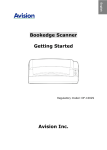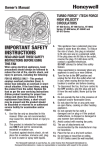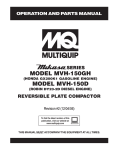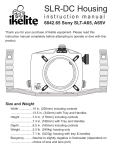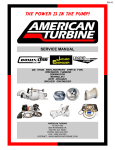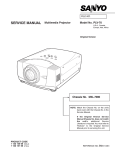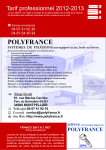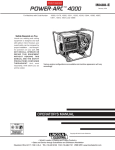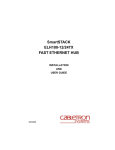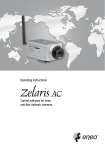Download Ventry POSITIVE PRESSURE VENTILATION FANS Owner`s manual
Transcript
OWNER’S MANUAL POSITIVE PRESSURE VENTILATION FANS By Ventry Solutions, Inc. FOR POSITIVE PRESSURE ATTACK AND VENTILATION BY Ventry Solutions, Inc. Formerly J. Neils Enterprises, Inc. 14128 N. Hauser Lake Road Hauser, ID 83854 (888) 257-8967 • (208) 773-1194 Fax: (208) 777-0360 Thank you for purchasing a VENTRY® Positive Pressure Ventilation Fan made by Ventry Solutions, Inc. Our experience as volunteer fire fighters, coupled with feedback from fire fighters across the country, has helped make this fan the best on the market. If you have any comments, ideas, observations or creative uses, please contact us by phone, email, mail or fax so that we may continue to improve our product. Fan Serial Number: ________________________________________________ Fan Size/Model: __________________________________________________ Engine Serial Number: _____________________________________________ Invoice Number: __________________________________________________ Invoice Date: _____________________________________________________ Patent 5,503,526 Copyright 2010 Ventry Solutions, Inc., Fifth Edition Printed February 12, 2010 TABLE OF CONTENTS FAN SPECIFICATIONS .................................................................................................. 1 ADVANTAGES OF VENTRY® ALL TERRAIN FANS ...................................................... 2 OUT OF THE BOX .......................................................................................................... 3 FAN TRANSPORT .......................................................................................................... 3 One Person Carry ....................................................................................................... 3 Two Person Carry ....................................................................................................... 3 LEG ADJUSTMENT ........................................................................................................ 4 How to raise the fan with one person .......................................................................... 4 Another method of raising the fan, one person ........................................................... 6 How to lower the fan, one person ............................................................................... 6 HOW TO USE POSITIVE PRESSURE VENTILATION................................................... 7 PPV The Basics .......................................................................................................... 7 Placement ................................................................................................................... 8 Smoke Ejection ........................................................................................................... 8 FAN SAFETY .................................................................................................................. 8 Safety Guidelines ........................................................................................................ 8 Ground Debris Pickup / Maximum Air Volume ............................................................ 9 Stability ....................................................................................................................... 9 Filling the Gas Tank .................................................................................................... 9 Backdraft Situations .................................................................................................... 9 COMMON QUESTIONS ABOUT POSITIVE PRESSURE ............................................ 10 Why positive instead of negative pressure ventilation? ............................................. 10 When should positive pressure not be used? ........................................................... 10 What is the door seal and how important is it?.......................................................... 10 What are some examples of positive pressure ventilation? ...................................... 10 FAN COMPARISON METHODS ................................................................................... 11 Ribbon Test............................................................................................................... 11 Volume Test .............................................................................................................. 11 Thrust Test ................................................................................................................ 11 WARRANTY .................................................................................................................. 12 Propeller / Frame / Guard ......................................................................................... 12 Engine ....................................................................................................................... 12 ii MAINTENANCE ............................................................................................................ 12 Engine Maintenance ................................................................................................. 12 Kevlar & Fiberglass-Coated Propeller ....................................................................... 12 Frame Maintenance .................................................................................................. 12 Tachometer ............................................................................................................... 12 TROUBLE SHOOTING ................................................................................................. 12 Fan walks during operation ....................................................................................... 12 Leg movement obstructed......................................................................................... 13 Fan too large to fit compartment ............................................................................... 13 PARTS ORDERS .......................................................................................................... 13 PARTS LIST FOR 20 INCH FRAME ............................................................................. 14 PARTS LIST, 20 INCH FRAME WITH WHEEL AND HANDLE OPTION ...................... 14 20 Inch Frame Assembly Diagram ............................................................................ 15 PARTS LIST 24 INCH FRAME ..................................................................................... 16 PARTS LIST, 24 INCH FRAME WITH WHEEL AND HANDLE OPTION ...................... 16 24 Inch Frame Assembly Diagram ............................................................................ 17 PARTS LIST FOR ENGINE, TACH AND SPARK ......................................................... 18 Spark Arrester and Stickers GX Series Engines ....................................................... 18 Spark Arrester and Stickers Honda GC135 Engine .................................................. 18 Tachometer/Hour Meter ............................................................................................ 19 PARTS LIST FOR GUARD MOUNT ............................................................................. 20 Guard Mount Pictures ............................................................................................... 21 PROPELLER ORIENTATION ....................................................................................... 22 PARTS LIST FOR PROPELLER MOUNT..................................................................... 22 Propeller Hubs and Tab Washer Pictures ................................................................. 23 PARTS LIST FOR FRONT OF GUARD ........................................................................ 24 Guard Front Picture .................................................................................................. 24 PARTS LIST FOR LIGHT OPTION ............................................................................... 25 Light Option Pictures ................................................................................................. 25 TORQUE VALUES ........................................................................................................ 26 iii POSITIVE PRESSURE VENTILATION FANS FAN SPECIFICATIONS Fan Dimensions Inches 1 Size Ext 31½ 32½ 38½ 35½ 36 43½ 2 Rtd Depth 21¼ Width 23¼ Height 23¼ Depth 22¼ Width 27½ 24 Height 28¼ Inch Depth Fan 37¾ 24½ Kohler 1 Ext = fan with extended legs 2 Rtd. = fan with retracted legs 20 Inch Fan Figure 1. Fan Dimensions Note the asymmetrical appearance of the fan, both from the front and the side. These are design aspects that keep the fan from walking. Volume Motor Size 24 Inch 20 Inch (CFM) Brand HP Extended Retracted Honda GX120 Honda GC135 Briggs Koolbore Honda GX200 Kohler Made USA Honda GX160 Honda GX120 Honda GC135 Briggs Koolbore 4 4 3.5 6.5 6 5.5 4 4 3.5 16500 16500 12500 29500 25000 24000 20000 20000 15000 16100 16400 11900 27800 24400 23600 19600 19600 14800 Thrust Weight (Lbs) (Lbs) 12.7 12.7 12.3 24.4 21.9 19.8 17.6 17.6 13.8 CO (PPM) Dry Wet 55 54 50 78 77 68 62 61 58 61 59 55 85 83 76 68 66 63 17 26 22 19 -32 16 25 23 Light Option can be added to the Honda GX120 and Honda GX160 Motors Tachometer and or spark arrester can be added to any fan. Solid rubber wheels and handle option adds 2.5 lbs to weight with no change in size Pneumatic tires & handle option adds 7 lbs to weight, 5 in to width, 2 in to depth, & 2 in to height. Figure 2.Table of Fan Specifications 1 VENTRY SOLUTIONS, INC. ADVANTAGES OF VENTRY® ALL TERRAIN FANS Figure 3. Independently Extendable Legs Elevates air stream over obstacles and into elevated or awkward openings Straddles obstacles, stands securely on uneven ground such as stairs and minimizes "walking" Allows maximum flexibility in aiming air stream up and down at steep angles CO levels well below the 35 PPM warning levels Legs operate throughout full range of extension yet retract to fit a small compartment Narrow air cone allows fan placement further from the structure opening to permit easy access Efficient prop design allows for maximum air volume and quiet operation Simple design for easy field service and next day factory parts availability Five-year warranty on all materials and workmanship 2 POSITIVE PRESSURE VENTILATION FANS OUT OF THE BOX After unpacking your fan there are a couple of things you will need to do. First, add fuel and oil. Oil amounts and specifications are listed in the engine manual under servicing. All models use 0.63 quart of 10W-30 oil. FAN TRANSPORT One Person Carry (Figure 4) Face the propeller, grip side handles with both hands and lift, pressing guard against body. Figure 4. One Person Carry Two Person Carry (Figure 5) Left and right persons grasp corresponding seven handles. Figure 5. Two Person Carry 3 VENTRY SOLUTIONS, INC. LEG ADJUSTMENT Please note that these are just suggested ways of raising and lowering the fan. Each firefighter finds a way to set the fan up that works best for them. How to raise the fan with one person Figure 6 Step 1 Figure 7 Step 2 Step 1: Loosen all three leg adjustment knobs. Step 2: Rock the fan on two legs, one front and one rear allowing the other front leg to extend. Figure 8 Step 3 Figure 9 Step 4. Step 3: Tighten the leg lock handle on the extended leg. Step 4: Rock fan onto rear and extended front leg allowing the other front leg to extend. 4 POSITIVE PRESSURE VENTILATION FANS Figure 10 Step 5 Figure 11 Step 6 Step 5: Tighten the leg lock handle on the extended front leg. Step 6: Rock the fan on the two extended legs while adjusting the remaining leg. Figure 12 Step 7 Figure 13 Step 8 Step 7. Aim and tighten rear leg Step 8. Start fan and check stability. 5 VENTRY SOLUTIONS, INC. Another method of raising the fan, one person Figure 14 Step 1. Figure 15 Step 2. Figure 16 Step 3. Step 1: Loosen all three legs adjustment knobs. Step 2: Lift the fan into a one person carry position allowing legs to extend. Step 3: Tighten one leg, whichever is most convenient. Figure 17 Step 4. Figure 19 Step 5. Figure 18 Step 6. Step 4: Balance the fan on the secured leg while adjusting the remaining front leg. Step 5: Balance on front legs while aiming the fan. Tighten rear leg adjustment knobs. Step 6: Start the fan and check stability. How to lower the fan, one person Step 1: Grasp handle of fan for support and loosen all leg adjustment knobs. Step 2: Use a rocking motion to lower the legs (Fig 20). Step 3: Tighten all three leg adjustment knobs. Figure 20 Lowering Fan 6 POSITIVE PRESSURE VENTILATION FANS HOW TO USE POSITIVE PRESSURE VENTILATION PPV The Basics Positive pressure ventilation (PPV) is a powerful tool for fire fighting but, like a doubleedged sword, it can cut both ways. Training and careful planning are essential if PPV is going to work to its full potential. Remember the basic fire triangle (heat, air, fuel). PPV reduces the temperature by displacing the hot flammable gasses, but it also provides the fire with an abundant source of oxygen. Timing is the key: have everything ready for the initial attack before positive pressure is used. The size-up needs to be done, incident command needs to develop a plan which uses an aggressive initial attack, lines need to be setup and charged, and firefighters in SBA’s need to be ready to attack the fire seat. Use PPV to blow the heat and smoke out of the structure, then get in and put the fire out before the increase in oxygen has a chance to let the fire flair up. Figure 14 is a simple example of the fan's proper use. RIGHT! Figure 21. Proper Fan Operation The size-up should look for exterior signs that indicate the fire seat's probable location. Use that information to develop an initial attack plan that ventilates by pushing the heat and combustible gases out of the structure near the seat of the fire. In actual practice it is not always possible to locate the seat of the fire during the initial size-up. In such cases, we've found that using positive pressure at the most convenient point of entry and venting on the opposite end of the structure works well. If possible, take into consideration which way the atmospheric wind is blowing, especially a strong wind, because working with the wind is more effective than trying to overpower it. After the initial attack, positive pressure can be used to minimize smoke damage. Pressurize the structure starting at an upwind room. Open a window and let the room completely clear of smoke. Then close the window and entrance to that room. Proceed in a downwind direction to clear the rest of the rooms in the structure. The downwind technique prevents smoke from leaking back into rooms that have already been cleared and allows you to check for other fire seats; if an upwind room refills with smoke, you've got another fire seat to deal with. 7 VENTRY SOLUTIONS, INC. Placement Avoid operating the fan too close to a structure's opening. Position the fan 8 to 15 feet from an average 3' x 7' door. It is best to err on the side of placing the fan too far from the door to prevent the situation shown in Figure 22. Sufficient air volume is produced to achieve WRONG! positive pressure ventilation even without a perfect door seal. If the fan is properly positioned to optimize positive pressure ventilation, access to the structure will not be restricted. Smoke Ejection Figure 22. Fan too Close to the Door The positive pressure fan is designed to push air, as used for positive pressure ventilation techniques. It is not designed to handle the environment in which a smoke ejection fan operates, where air is pulled out of the structure (Figure 16). The propeller, gas tank and many components of the engine are made out of WRONG! materials that will not withstand high temperatures. If the fan is used as a smoke ejector, damage will not be covered by the manufacturer's warranty. FAN SAFETY Figure 23. Never Use as a Smoke Ejector Many years of research and development have gone into creating this piece of safety equipment. Still, if used incorrectly, the fan can be detrimental to the operation of a fire scene. Our experience shows the following techniques to be helpful in preventing unnecessary damage to the structure or injury to fire fighters. Always remember that ACTUAL FIRE SCENES VARY DRASTICALLY WITH EACH SITUATION so the ideas and techniques presented here are not always practical and may need to be modified to fit a specific situation. Safety Guidelines First, stop and think! What is going on here? What effect will this have? Each individual fire scene presents special problems that can't be anticipated in advance. Second, fire fighters should enter the structure from where the fan is set up so they follow the fresh air into the structure. This procedure allows the initial attack team to find victims or start extinguishing the fire. Do not set up the fan in a manner that will blow fire onto the fire fighters. Remember, have the wind at your back. Third, position the fan so that it blows the fire back on itself and out of the structure rather than into unaffected areas of the structure. For example, if the fire started burning near the front door, set the fan up at a back door to blow the fire out the front door rather than all the way through the structure. Fourth, open a minimum of windows and doors for ventilation. Having too many vents open will reduce the pressure inside the house and make positive pressure ventilation less 8 POSITIVE PRESSURE VENTILATION FANS effective. The air will take the path of least resistance. If you have a lot of windows and doors open the air will most likely take a path that isn’t the one you want to remove the smoke. Ground Debris Pickup / Maximum Air Volume This positive pressure fan is designed to run with the legs partially extended. By extending the legs, two important things are accomplished. First, running the fan with the legs extended eliminates ground debris pickup and ejection which causes propeller damage. Second, the efficiency (air volume) is increased. Operating the fan close to the ground can reduce the air volume significantly. Raising the fan allows it to draw air from completely around the guard, rather than trying to "suck air out of the ground". We suggest that you raise the fan at least six (6) inches. Ideally you raise the fan all of the way. This maximizes the fan performance and makes it easier to start. With the controls up where they are easy to reach firefighter doesn’t have to bend way over or kneel to start the fan, minimizing firefighter fatigue. Stability After placing the fan in the desired position, check the fan's stability. Start the fan while stabilizing it with one hand. Open the throttle all the way and rock the fan from side to side. This will let you determine how stable the fan is. If necessary, adjust leg lengths to achieve a stable position. At this time, inspect the placement of the positive pressure fan and confirm that it is not walking. Some wooden decks and stairways will vibrate and cause the fan to walk. A simple change of the throttle setting can eliminate this problem. Decreasing the throttle also works on slick surfaces. Filling the Gas Tank Never fill the gas tank with the fan in operation. Turn off the engine and allow it to cool before refueling. A small spill or miscalculation while filling a running fan can introduce gas into the air stream causing a cloud of vaporized fuel to enter a burning structure. Your imagination can picture the result. Backdraft Situations Alternate ventilation techniques are necessary in the case of a backdraft situation and the use of a positive pressure fan is not recommended. After the backdraft situation has been rectified the PPV can be used. 9 VENTRY SOLUTIONS, INC. COMMON QUESTIONS ABOUT POSITIVE PRESSURE Why positive instead of negative pressure ventilation? Stand on the suction side of a fan -- there's not much happening. Now stand downwind and note the difference. The same thing happens in a structure just as dramatically: with positive pressure, smoke and heat come blasting out of the structure and visibility improves in a matter of seconds. Additionally, positive pressure is much faster to set up. Since our positive pressure fan sits 8' to 15' from the entrance point, unlike a negative pressure set-up, it doesn't block access points. When should positive pressure not be used? Never use positive pressure ventilation when a victim is hanging out of a window. The use of positive pressure ventilation could push hot gases out of that window placing them in an environment that could do great harm. Never use positive pressure ventilation in a back draft situation since that condition involves super-heated gases that will ignite explosively when oxygen is introduced. Some of the warning signs are dark puffing smoke, heavy soot on windows and rapid air intake when an opening is made. Beware of tight structures for possible back draft! What is the door seal and how important is it? Proper fan placement lets the fan's cone of air cover the entry opening so that air doesn't leak out of the opening. This provides a seal and delivers the most pressure and air volume to the structure. Experience has taught us that a high output fan such as ours puts out enough air that a perfect seal is not very important. On an air-tight structure a tight seal is actually impossible to establish since the air forced into the structure has to come out somewhere. An effective technique on large structures, where a lot of air is needed, involves using one fan set back to establish a seal and one up close to increase the air volume forced into the structure. A useful training exercise involves taping toilet paper around a door opening and then locating the fan in such a fashion that all the toilet paper blows into the structure. Note: don't overemphasize the importance of creating a perfect air seal on every fire scene; there are a lot more important things to worry about in real situations. What are some examples of positive pressure ventilation? Occasionally, our fire department will respond to a call such as some innocent homeowner who has just emptied his stove's ashes into a plastic bucket without realizing they were still hot. In a situation like this, the fan gets rid of the accumulated smoke fast so we can determine its source. The fan becomes a good public relations tool because we've cleared the smoke and located the problem quickly. Since these fires usually occur late in the evening, we're happy to get back to bed promptly with a minimum of excitement. Another favorite of ours is a smoldering attic fire caused by a faulty chimney or the old dime-behind-a-fuse trick. Without creating a vent opening, we use the fan to pressurize the house. Enough air will leak into the attic to clear the smoke so that we can locate the individual curls of smoke that mark the hot spots. We then use a bucket to scoop up the smoldering insulation thereby avoiding any water damage. 10 POSITIVE PRESSURE VENTILATION FANS Positive pressure is also very useful to pressurize areas of a structure to prevent or slow down fire spread into uninvolved areas. We stopped a fire in a 6 unit apartment building using this technique with three fans pressurizing the central foyer. We just opened the door to the apartments that we wanted pressurized. The heavy, smoldering smoke that usually accompanies pack rat conditions just begs for positive pressure; the smoke must be cleared or it will take forever to find the fire seat. Recently we ran mutual aid to a cabin roof fire. The roof was constructed using plank and beam techniques. Fire had followed the cracks between the planks and could be seen from inside the cabin. We pressurized the cabin enough that the water we sprayed on the roof didn't come through the seams in the ceiling; we watched the water pour into the burning seams and get blown right back out by the escaping pressurized air. The house incurred no water damage even though the roof had started to burn through! These stories illustrate situations in which positive pressure ventilation has been used successfully. With a little imagination and training, your department is sure to discover many more creative uses. Good luck, and remember, luck favors a prepared mind! FAN COMPARISON METHODS Ribbon Test Several departments have described a simple test that you can use to compare the output of two fans. These departments took two blowing fans and aimed them at each other, approximately 12 feet apart. A ribbon was held half-way between to determine which way the air was blowing. Volume Test We found a culvert 4 feet in diameter. A fan was placed far enough away from the opening of the culvert to obtain a complete air seal. We then released soap bubbles into the air stream moving through the culvert and timed how long the bubbles (air) took to pass completely through the culvert. We could then calculate the volume of air flow that the fan produced. This analytical technique has allowed us to optimize the propeller design so that the maximum amount of air is moved. Thrust Test Basic physics states “For every action there is an equal but opposite reaction”. It follows that measuring thrust is an easy way to compare fan performance. You will need a flat board strong enough to hold the fan. You will also need two dowels (any long rounded pole--even broomsticks will do.) You will also need a fish scale, preferably digital, with which to measure thrust. Find a smooth surface, like a shop floor or a concrete ramp, with lots of room around it. Place the two dowels on the surface parallel to each other. Upon these, place the flat board. Check to make sure that the board roles freely. Place the fan on the board. Attach one end of the fish scale to the front of the fan or the board near the front of the fan and the other end attach to a stationary object on the ground. What this accomplishes is that when the fan is started up, the fan and the board will try to roll backwards, pulling on the fish scale. The thrust of the fan will be what the fish scale is measuring. 11 VENTRY SOLUTIONS, INC. WARRANTY Propeller / Frame / Guard Five years on workmanship and materials. Prop erosion caused by operation of a fan over loose materials without elevating the fan high enough to avoid picking up loose materials is not covered under warranty Engine For the engine manufacturer's warranty, see engine manual. Contact your local Honda, Kohler or Briggs & Stratton dealer for further details. MAINTENANCE Engine Maintenance Refer to the engine manufacturer's manual. Kevlar & Fiberglass-Coated Propeller Propellers coated with Kevlar and Fiberglass are extremely resistant to wear and tear, and require little to no maintenance other than occasional cleaning to maintain balance. Some wear of the paint on the leading edge should be expected. If touch-up painting is required, use a white polyurethane enamel. Be sure to balance the propeller before placing it back on the fan to ensure that the fan does not walk. Significant damage which penetrates the fiberglass/kevlar coating may require evaluation and repair by Ventry Solutions. Frame Maintenance Wipe down the frame to remove dirt and grease buildup The rubber leg bottoms (jumbo crutch tips) will need to be inspected for wear. Damage such as missing pieces may allow the fan to walk. Replacements may be obtained through the manufacturer or at a local medical supply outlet. Tachometer Refer to the Tiny-Tach literature that came with the fan for general information. For installation refer to the diagram on page 19. TROUBLE SHOOTING Fan walks during operation Worn out Rubber Leg Ends: Look to see if the leg ends are worn out. If they have a lot of wear you may be able to rotate then on the end of the legs. This will place a new section of rubber into service. Otherwise give us a call for a new pair or go down to the local pharmacy and get a new set. Out-of-Balance Propeller: An imbalance in the propeller can be caused by impact or by abrasion. Light abrasion is considered normal wear and can be repaired by light sanding and repainting. Propeller balance can be checked by inserting a 5/16 inch steel rod through the propeller center hole. Roll the rod across two level parallel edges. Make sure that there is no breeze present while doing this procedure. The light portion of the propeller will rotate to the top. This can be a tip, side or anywhere in-between. Add paint to the light portion or sand the heavy portion to balance the propeller. If you have problems contract the manufacturer. 12 POSITIVE PRESSURE VENTILATION FANS Bent Frame: Ventry Solutions’ positive pressure fan is by no means symmetrical. If you position yourself behind the fan on its right side, the closest leg should be angled several degrees ahead of the left leg. This same leg also leans out more than the left leg does. These are design aspects engineered into the fan to increase the stability and to prevent walking. Figure 1 gives you an idea of how it should look. If the legs do not resemble the picture, the frame or leg may be bent and will need to be straightened or replaced. Contact the manufacturer. Operating Surface: Some surfaces such as wooden decks or stairways vibrate causing the fan to walk. Adjusting the throttle will sometimes eliminate this problem. Some fans will move backwards if placed on extremely smooth surfaces. Because the fan produces up to 17 pounds of thrust, surface friction may not be great enough to keep the fan stationary. In this case, reduce the throttle until the fan quits moving. Leg movement obstructed If a front or rear leg sticks, several things may be occurring. First, check to see that the leg adjustment handles are completely loosened. If this is not the problem, remove the crutch tip and roll pin, then remove the leg from the frame. Then file the inside of the frame where the adjustment handles are inserted. Also check around the top of the frame to see if obstructions are present. Remove any dirt and grease that might be clogging the frame. On rear legs, the top leg hole may require a light filing to remove any roughness. If a leg is still not sliding freely, check the frame and leg for any abnormal bends. Replacement may be necessary. Fan too large to fit compartment Contact Ventry Solutions, Inc. for possible solutions. PARTS ORDERS This is the information we need to make sure that we get correct parts for your fan. Fan#: ___________________________________________ Engine Serial #: ___________________________________ Options: _________________________________________ We keep a record of each fan we sell. If we get this information we will make notes in our database about your specific fan which will enable us to give you the best service in the future. 13 VENTRY SOLUTIONS, INC. All nuts, bolts and washers are grade 5 or 8, national fine, zinc coated or better. Replacement parts will be sent UPS 2nd Day Air unless otherwise requested. PARTS LIST FOR 20 INCH FRAME Reference Number 01 02 03 07 08 09 10 13 14 15 16 17 18 19 20 21 22 23 24 Part Number F-1009 F-1004S F-1001A F-1010 F-1018 F-1012 F296600 F-1008 F-1007 F-1006 F-1013 F-1002S F-1003S F-1019 F-1020 G-1024 F-94225 F-1005 F-7N04C Quantity Leg cap, 3/4” ............................................................................................... 3 20” Leg, rear ............................................................................................... 1 20” Frame with out wheel option ................................................................ 1 Short foam handle ....................................................................................... 2 7/8 Round cap ............................................................................................. 2 20” “Seven” handle, left ............................................................................. 1 Rubber leg ends (jumbo crutch tips), 2” diameter ...................................... 3 Roll pins, 1¼” x 3/16” ................................................................................ 5 Leg adjustment handles............................................................................... 3 Leg adjustment springs ............................................................................... 3 20” “Seven” handle, right ........................................................................... 1 20” Leg, left (as seen from in front of the fan) ........................................... 1 20” Leg, right (as seen from in front of the fan) ......................................... 1 Motor mount bolts front with washers and nuts.......................................... 2 Motor mount bolts rear with washers and nuts ........................................... 2 Guard mount bracket aluminum ................................................................. 1 Flat socket cap screw .................................................................................. 1 Long foam handle ....................................................................................... 1 Tubing nut ................................................................................................... 1 PARTS LIST, 20 INCH FRAME WITH WHEEL AND HANDLE OPTION Reference Number 01 02 04 05 06 07 08 09 10 11 12 13 14 15 16 17 18 19 20 21 22 24 25 14 Part Number F-1009 F-1004S F-33827 F-1021 F-1022 F-1010 F-1018 F-1012 F296600 F-1023 F-1G339 F-1008 F-1007 F-1006 F-1013 F-1002S F-1003S F-1019 F-1020 G-1024 F-94225 F-7N04C F-1001W Quantity Leg cap, 3/4” ............................................................................................... 6 20” Leg, rear ............................................................................................... 1 Hand activated plunger ............................................................................... 1 Towing handle lock nut, washer & spring .................................................. 1 Towing handle ............................................................................................ 1 Short foam handle ....................................................................................... 5 7/8 Round cap ............................................................................................. 4 20” “seven” handle, left .............................................................................. 1 Rubber leg ends (jumbo crutch tips), 2” diameter ...................................... 3 5/16 Wheel mounting hardware (bolts, washers, nuts) ............................... 2 Wheels 4 inch.............................................................................................. 2 Roll pins, 1¼” x 3/16” ................................................................................ 5 Leg adjustment handles............................................................................... 3 Leg adjustment springs ............................................................................... 3 20” “Seven” handle, right ........................................................................... 1 20” Leg, left (as seen from in front of the fan) ........................................... 1 20” Leg, right (as seen from in front of the fan) ......................................... 1 Motor mount bolts front with washers and nuts.......................................... 2 Motor mount bolts rear with washers and nuts ........................................... 2 Guard mount bracket aluminum ................................................................. 1 Flat socket cap screw .................................................................................. 1 Tubing nut ................................................................................................... 1 20 Inch frame with wheel option ................................................................ 1 POSITIVE PRESSURE VENTILATION FANS 20 Inch Frame Assembly Diagram 15 VENTRY SOLUTIONS, INC. PARTS LIST 24 INCH FRAME Reference Number 01 02 03 07 08 09 10 13 14 15 16 17 18 19 20 21 22 24 26 Part Number F-1009 F-1004L F-1001B F-1010 F-1018 F-1015 F296600 F-1008 F-1007 F-1006 F-1014 F-1002L F-1003L F-1019 F-1022 G-1024 F-94225 F-7N04C F-1024 Quantity Leg cap, 3/4” ............................................................................................... 3 24” Leg, rear ............................................................................................... 1 24” Frame with out wheel option ................................................................ 1 Short foam handle ....................................................................................... 2 7/8 Round cap ............................................................................................. 2 24” “Seven” handle, right ........................................................................... 1 Rubber leg ends (jumbo crutch tips), 2” diameter ...................................... 3 Roll pins, 1¼” x 3/16” ................................................................................ 6 Leg adjustment handles............................................................................... 3 Leg adjustment springs ............................................................................... 3 24” “Seven” handle, left ............................................................................. 1 24” Leg, left (as seen from in front of the fan) ........................................... 1 24” Leg, right (as seen from in front of the fan) ......................................... 1 Motor mount bolts front with washers and nuts.......................................... 2 Motor mount bolts rear with washers and nuts ........................................... 2 Aluminum guard mount .............................................................................. 1 Flat socket cap screw .................................................................................. 1 Tubing nut ................................................................................................... 1 24 Role bar .................................................................................................. 1 PARTS LIST, 24 INCH FRAME WITH WHEEL AND HANDLE OPTION Reference Number 01 02 04 05 06 07 08 09 10 11 12 13 14 15 16 17 18 19 20 21 22 24 25 27 16 Part Number F-1009 F-1004L F-33827 F-1021 F-1022 F-1010 F-1018 F-1015 F296600 F-1023 F-1G345 F-1008 F-1007 F-1006 F-1014 F-1002L F-1003L F-1019 F-1020 G-1024 F-94225 F-7N04C F-1004W F-1025 Quantity Leg cap, 3/4” ............................................................................................... 6 24” Leg, rear ............................................................................................... 1 Hand activated plunger ............................................................................... 1 Lock nut washer & spring for towing handle.............................................. 1 Towing handle ............................................................................................ 1 Short foam handle ....................................................................................... 4 7/8 Round cap ............................................................................................. 4 24” “Seven” handle, right ........................................................................... 1 Rubber leg ends (jumbo crutch tips), 2” diameter ...................................... 3 5/16 Wheel mounting hardware (bolts, washers, nuts) ............................... 2 Wheels 5 inch.............................................................................................. 2 Roll pins, 1¼” x 3/16” ................................................................................ 6 Leg adjustment handles............................................................................... 3 Leg adjustment springs ............................................................................... 3 24” “Seven” handle, left ............................................................................. 1 24” Leg, left (as seen from in front of the fan) ........................................... 1 24” Leg, right (as seen from in front of the fan) ......................................... 1 Motor mount bolts front with washers and nuts.......................................... 2 Motor mount bolts rear with washers and nuts ........................................... 2 Aluminum guard mount .............................................................................. 1 Flat socket cap screw .................................................................................. 1 Tubing nut ................................................................................................... 1 24 Inch frame with wheel option ................................................................ 1 24 Roll bar with handle mount.................................................................... 1 POSITIVE PRESSURE VENTILATION FANS 24 Inch Frame Assembly Diagram 17 VENTRY SOLUTIONS, INC. PARTS LIST FOR ENGINE, TACH AND SPARK Spark Arrester, Stickers and Honda GX Series Engines Reference Number 01 02 03 04 05 Part Number S-1034 E-DA14 E-DC13 E-DC13 E-GX120K1 E-GX120K1E E-GX160K1 E-GX160K1E E-GX200K1 E-GX200K1E Quantity Spark arrester (Honda GX series engines) w/screw.................................... 1 Address decal .............................................................................................. 1 Caution decal .............................................................................................. 1 Throttle decal .............................................................................................. 1 Engine, one of the following: Honda, 4 HP ..................................................................................... 1 Honda, 4 HP with alternator ............................................................. 1 Honda, 5.5 HP .................................................................................. 1 Honda, 5.5 HP with alternator .......................................................... 1 Honda, 6.5 HP .................................................................................. 1 Honda, 6.5 HP with alternator .......................................................... 1 Spark Arrester, Stickers and Honda GC135 Engine Reference Number 02 03 06 07 18 Part Number E-DA14 E-DC13 E-GC135 S-1036 Quantity Address decal .............................................................................................. 1 Caution decal .............................................................................................. 1 Honda GC135, 4 HP ................................................................................... 1 Spark arrester (Honda GC135 engines) w/screw ........................................ 1 POSITIVE PRESSURE VENTILATION FANS Tachometer/Hour Meter Reference Number 01 02 03 04 Part Number T-1031 T-1032 T-W075 Quantity Tiny-Tach ................................................................................................... 1 Self-tapping screws, 8 x 3/8" ...................................................................... 2 Wire ties, 50# test ....................................................................................... 2 Motor Mount Bolt holding Grounding Clip ................................................ 1 19 VENTRY SOLUTIONS, INC. PARTS LIST FOR GUARD MOUNT Reference Number 01 02 03 04 05 06 07 08 09 10 11 Part Number G-1024 G-1035 F94225 G-1030 G-1031 G-1035 G-1036 G-1021 G-1020 G-1032 G-1037 G-1033 G-1034 12 13 14 G-1027 Quantity Guard mount bracket .................................................................................. 1 1/8 U-bolt with nuts .................................................................................... 1 ¼” x 1” Flat socket cap screw..................................................................... 1 Guard mounting hardware, ¼ NF ............................................................... 2 Guard mounting hardware, 5/16 NF ........................................................... 4 Guard mount spacers one of the following Guard mount spacers for Honda GX series motors .................................... 4 Guard mount spacers for Honda GC135 motors ......................................... 4 5/16 SAE washers GD8 ............................................................................ 12 5/16 Split lock washer GD8 ........................................................................ 4 ¼ Nylock GD8 ............................................................................................ 2 Neobond washers ........................................................................................ 4 Guard, one of the following: 20" fan rear guard ............................................................................. 1 24" fan rear guard ............................................................................. 1 Engine, (See pages 16 and 17)1 Stand (see pages 12-15) ¼ SAE washers GD8 .................................................................................. 6 Note the number and position of the washers, reference numbers 7 and 14. The placement of these washers is important to keep everything lined up properly especially for the 5/16 bolts attaching the guard to the motor crank case. If you leave out washers the 5/16 bolts can go to deep into the blind holes and can break the engine crank case. Please be careful 20 POSITIVE PRESSURE VENTILATION FANS Guard Mount Pictures 21 VENTRY SOLUTIONS, INC. PROPELLER ORIENTATION Toward Crush Plate Toward Engine PARTS LIST FOR PROPELLER MOUNT Reference Number 01 02 03 04 05 06 07 08 09 10 Part Number P-1026 P-1029 P-1028 P-1027 P-1025 E-H002 P-1030 P-1031 P-1032 P-2002G P-2002B P-2404G 22 Quantity Stainless set screw ...................................................................................... 1 Cap screw, (prop safety bolt), 5/16" x ¾" ................................................... 1 Internal star washers, 5/16"......................................................................... 1 Fender washer, 5/16" .................................................................................. 1 Hub, aluminum ........................................................................................... 1 Engine key ................................................................................................. 1 Crush plate .................................................................................................. 1 Cap screws, 5/16" x 3"................................................................................ 4 Retention washers ....................................................................................... 4 Propellers (one of the following) 20", Wood/kevlar/fiberglass composite .......................................... 1 20", Wood/kevlar/fiberglass composite Briggs 3.5 hp .................... 1 24", Wood/kevlar/fiberglass composite ........................................... 1 POSITIVE PRESSURE VENTILATION FANS Propeller Hubs and Tab Washer Pictures 23 VENTRY SOLUTIONS, INC. PARTS LIST FOR FRONT OF GUARD Reference Number 01 02 03 Part Number G-1038 G-1039 G-W075 G-1040 Guard Front Picture 24 Quantity Guard front, one of the following: 20” Fan guard front ..................................................................................... 1 24” Fan guard front ..................................................................................... 1 Ventry® fan sticker...................................................................................... 1 ¼” Nylon lock nut and ¼ SAE washer ...................................................... 4 POSITIVE PRESSURE VENTILATION FANS PARTS LIST FOR LIGHT OPTION Reference Number 01 02 03 04 05 06 07 08 09 10 11 12 Part Number L-80378 L-1001 L-1002 L-1003 L-1004 L-1005 T-W079 L-1006 L-1007 L-1009 H-7614 Quantity Light housing with switch ........................................................................... 1 Butt connector ............................................................................................. 1 Upper light mounting hardware .................................................................. 1 Lower light mounting hardware .................................................................. 1 Frame (see frame parts list and picture) Fuse holder.................................................................................................. 1 Electrical tape ............................................................................................. 1 Wire tie ....................................................................................................... 1 Wire ............................................................................................................ 1 Star washer and ring tong terminal ............................................................. 1 Spade connectors ........................................................................................ 2 Light with screws ........................................................................................ 1 Light Option Pictures 25 VENTRY SOLUTIONS, INC. TORQUE VALUES Fan Component 26 Torque Values (ft. lbs.) 5/16" Cap screw (engine mounting bolts) 17 to 21 ¼" x ½" Cap screw (rear guard to guard mount tubing) 9 to 11 5/16" Cap screw (rear guard to aluminum engine block) 8 to 10 Propeller hub set screw 9 to 11 5/16" x 3/4" Cap screw (propeller safety bolt) 17 to 21 5/16" x 3" Cap screw (propeller bolts) 10 to 12 ELECTRIC VENTRY FANS OPERATING INSTRUCTIONS Please use this instruction sheet along with the blue or green VENTRY Fan owners manual also included with your fan, a booklet entitled “VENTRY All-Terrain Attack Fans, Owner’s Manual.” 1. Make sure the Power (PWR) switch is turned to OFF. 2. Extend the fan legs a minimum of 6 inches. (See “Leg Adjustment” section of Owners Manual” for instructions) 3. Plug the fan in. 4. Turn the PWR switch to ON. 5. Turn the middle switch from STOP to RUN (either direction will work equally well). 6. Set the variable speed dial to the desired setting. From the factory, the digital display is set to show revolutions per minute (RPM). You can toggle the display to show RPM, hertz (H) or amps (A) of the motor by pressing the PROGRAM button. Programming of the electric drive is done at the factory using the supplemental programming buttons. No further programming should be necessary. Thank you for choosing VENTRY Fans. Please call us toll-free with any questions. Ventry Solutions, Inc. | (888) 257-8967 Manufactured by Ventry Solutions, Inc. (formerly J. Neils Enterprises, Inc.) (888) 257-8967
































